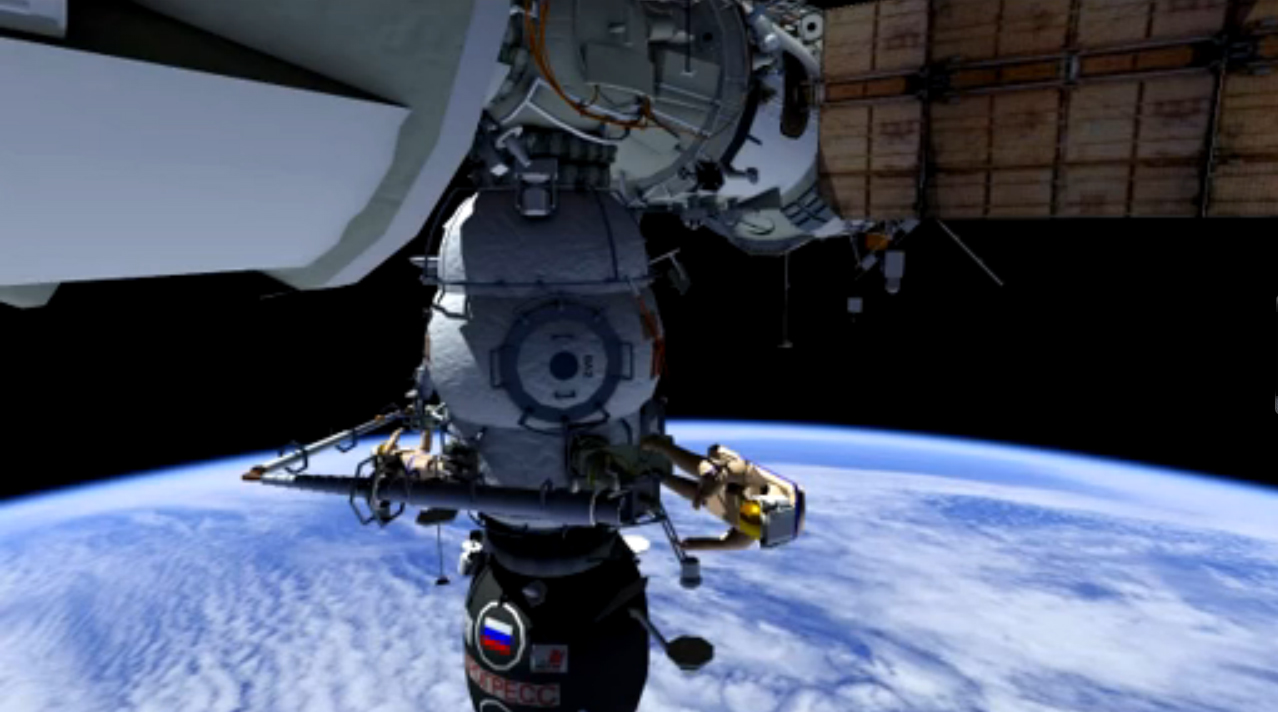Russian Cosmonauts Float Outside Space Station on Spacewalk

This story was updated at 9:52 a.m. ET.
Two Russian cosmonauts ventured outside the International Space Station today (Feb. 16) to prepare their orbiting laboratory for the arrival of a brand-new module next year.
Cosmonauts Oleg Kononenko and Anton Shkaplerov will spend six hours working outside the space station in bulky spacesuits to move a 46-foot (14-meter) crane from one module to another and install vital shields to protect the outpost from space debris. The spacewalk began at 9:31 a.m. EST (1431 GMT), but the cosmonauts were delayed leaving the airlock due to a pesky cord that was in the way.
"We're ready to work," one of the cosmonauts said.
"That's great, let's go," Russia's Mission Control replied.
Today's orbital work is the first spacewalk of 2012 and is primarily focused on the space station's Pirs docking module, a room that has long served as an airlock for spacewalks and a parking spot for Russian spacecraft. The module is equipped with two cranes, both called Strela, which can be used to move spacewalkers to hard-to-reach spots on the station's Russian section or transport bulky pieces of equipment.
Unlike the space station's Canadian-built Canadarm2 robotic arm, the Strela cranes are unpowered. They are operated by a hand crank which cosmonauts turn in order to extend the crane to a desired length. [Photos: Building the Space Station]
Get the Space.com Newsletter
Breaking space news, the latest updates on rocket launches, skywatching events and more!
"That's a hand-operated telescoping pole," NASA's space station spacewalk officer Glenda Brown explained in a video.
During today's spacewalk, Kononenko and Shkaplerov will use one of the Strela cranes to move the other from the Pirs module, which is on the bottom of the space station, to a different module called Poisk on the orbiting lab's roof. The work is required because the Pirs modul e is expected to be discarded to make room for a new Russian Multipurpose Research Laboratory module and docking module.
The Pirs docking module has been attached to the space station since its arrival in 2001. Pirs means "Pier" in Russian and Poisk means "Explore." Zvezda translates to "Star."
Kononenko and Shkaplerov also plan to install five metal debris shields on the Zvezda module to protect it from hits by micrometeorites and tiny pieces of space junk. If time allows, the cosmonauts will also install new experiments on the Pirs and Poisk module, as well as some support struts on the Pirs module, NASA officials said.
The two spacewalkers will wear Russia-built Orlan spacesuits equipped with NASA helmet cameras for today's spacewalk. It will be the second career spacewalk for Kononenko and the first for Shkaplerov.
Kononenko and Shkaplerov are two members of the six-man Expedition 30 crew currently living aboard the International Space Station. Two Americans, another Russian and a Dutch astronaut round out the crew.
Today's spacewalk is the 162nd spacewalk dedicated to the construction and maintenance of the International Space Station, which was built by five different space agencies representing 15 countries. Construction of the $100 billion space station began in 1998.
You can watch the spacewalk live here: http://www.nasa.gov/ntv
You can follow SPACE.com Managing Editor Tariq Malik on Twitter @tariqjmalik. Follow SPACE.com for the latest in space science and exploration news on Twitter @Spacedotcom and on Facebook.
Join our Space Forums to keep talking space on the latest missions, night sky and more! And if you have a news tip, correction or comment, let us know at: community@space.com.

Tariq is the Editor-in-Chief of Space.com and joined the team in 2001, first as an intern and staff writer, and later as an editor. He covers human spaceflight, exploration and space science, as well as skywatching and entertainment. He became Space.com's Managing Editor in 2009 and Editor-in-Chief in 2019. Before joining Space.com, Tariq was a staff reporter for The Los Angeles Times covering education and city beats in La Habra, Fullerton and Huntington Beach. In October 2022, Tariq received the Harry Kolcum Award for excellence in space reporting from the National Space Club Florida Committee. He is also an Eagle Scout (yes, he has the Space Exploration merit badge) and went to Space Camp four times as a kid and a fifth time as an adult. He has journalism degrees from the University of Southern California and New York University. You can find Tariq at Space.com and as the co-host to the This Week In Space podcast with space historian Rod Pyle on the TWiT network. To see his latest project, you can follow Tariq on Twitter @tariqjmalik.